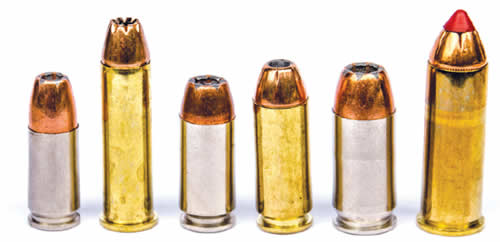Skip to comments.
The Versatible 10mm
Am Shooting Journal ^
| 7/7/2021
| J Brooks
Posted on 07/07/2021 9:33:45 AM PDT by w1n1
 First developed to combine the attributes of the 9mm Luger and the .45 ACP, this round is now one of the best handgun hunting cartridges made for semiautomatics.
First developed to combine the attributes of the 9mm Luger and the .45 ACP, this round is now one of the best handgun hunting cartridges made for semiautomatics.
Handgun shooters know that two of the most popular calibers are the 9mm Luger (Parabellum) and the .45 ACP. The latter is slow but makes a big hole, while the faster 9mm tends to lose energy quickly once it hits the target but shoots fast and flat. In a perfect world, a gunmaker would bridge these two rounds to make a fast and hard-hitting bullet.
It is this very idea that led Lieutenant Colonel John "Jeff" Cooper to come up with what we now know as the 10mm Auto. Back in 1983, the search began by looking at the speed of the 9mm Luger and the energy of the .45 ACP. The idea was that if a round could shoot fast, which means flatter trajectory, and could hit hard, then it would fit the military’s need, as well as that of law enforcement and civilian use for self-defense. The 10mm was created by taking a .30 Remington rifle case and cutting it down to .992 inch and opening the mouth large enough to seat the 10mm (.400-inch) bullet.
Overall length is 1.240 inches up to an acceptable 1.260 inches. The round shoots 180-grain bullets very well, but loads are available for lighter and faster projectiles down to 135 grains, which shoot nearly 400 feet per second faster than the 115-grain bullet out of a 9mm. It is also loaded with 200-grain powerhouses that shoot around 300 fps faster than the 230-grain .45 ACP. It seems that Lt. Col. Cooper was onto something when the 10mm was developed.
FIRST CALLED THE 10mm Super, the cartridge never really shined. This could be because there was already a 10mm Super on the market so a name change had to be made; this set back the rise to fame, as shooters didn’t know what the 10mm was all about. In 1989, the FBI decided to issue the 10mm to their agents. This occurred after the shootout in Miami, Florida, in which five FBI agents were injured and two were killed when they attempted to arrest two bank robbers. The agents were armed with .357 Magnums and .38 Specials, both revolvers.
After the incident the FBI realized they needed more firepower in their issued sidearms, both in ammo capacity and in bullet performance. Through testing, and like Lt. Col. Cooper, they decided the 10mm fit their needs. But there was one reason why the military and even the civilian world never really accepted the 10mm and that was felt recoil A fast and heavy round means there will be a bit of push back when you pull the trigger.
Smaller-framed agents couldn’t handle the recoil of the 10mm. When it comes to law enforcement, it is more important to hit your target with a light-shooting bullet than miss with a heavy one. For personal defense, a lot of times just producing a handgun will stop the encounter and then the loud bang could thwart the criminal. But for law enforcement, where each round has to be accounted for, it is imperative that the intended target is hit.
Because of this, the FBI decided to go with another new round on the market, very similar to the 10mm, the .40 Smith & Wesson (S&W). The .40 S&W was built on the 10mm case and bullet, using the same 10mm projectile but in a shorter case that held less powder, shot slower and therefore had less recoil. Most law enforcement departments today use the .40 S&W. Read the rest of versatile 10mm here.
TOPICS: Hobbies; Outdoors
KEYWORDS: 10mm; banglist; blogpimp; gearqueer; getaneditor; momsbasement; rkba; versatible
Navigation: use the links below to view more comments.
first previous 1-20, 21-40, 41 last
To: JD_UTDallas
“The Norwegians issue Glock 20s in 10mm specifically for polar bear defence and it has a proven track record with the Norwegian Artic forces in actual polar bear shootings.”.
Source?
Navigation: use the links below to view more comments.
first previous 1-20, 21-40, 41 last
Disclaimer:
Opinions posted on Free Republic are those of the individual
posters and do not necessarily represent the opinion of Free Republic or its
management. All materials posted herein are protected by copyright law and the
exemption for fair use of copyrighted works.
FreeRepublic.com is powered by software copyright 2000-2008 John Robinson
 First developed to combine the attributes of the 9mm Luger and the .45 ACP, this round is now one of the best handgun hunting cartridges made for semiautomatics.
First developed to combine the attributes of the 9mm Luger and the .45 ACP, this round is now one of the best handgun hunting cartridges made for semiautomatics.